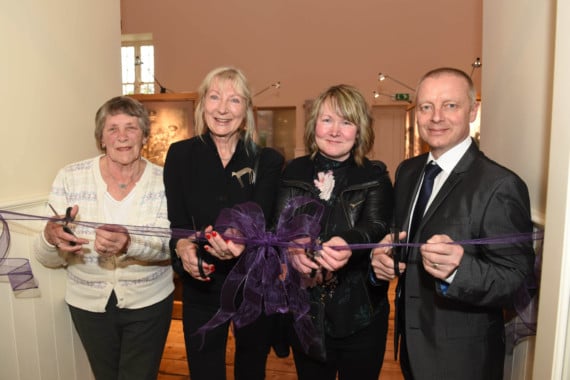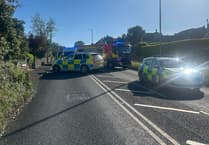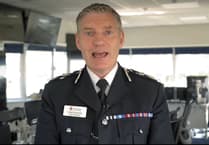Thousands of Knockaloe Camp internees and workers’ stories are now on display for the public to discover at the halls of Patrick Old School Rooms. Reporter Jess Ward tells us more.
It was a moment that marks a major milestone in the island and for global descendants of those who lived and worked in Knockaloe First World War Internment Camp.
Visitors packed into a hall of the former Patrick School for the official opening of the new Visitor Centre with the red ribbon being ceremonially cut by Cristl Jerry, Jonathan Grubb, Dawn Kennaugh and Trish Phillips-Nagel, whose grandfathers and ancestors were in the camp about 100 years before.
Opposite the visitor centre is the entrance of Knockaloe Moar Farm - the location of the internment camp that accommodated the ’enemy aliens’ of the British Government when the war broke out.
Back then the old school rooms acted as a courthouse. When the war was over and the camp was gone, it reverted to a school again until the 1980s. Following that, the community would use the crumbling space for activities.
It has now opened as a lovingly restored hub for people to wander among the collected memories relating to the camp.
These are presented in a thoughtful way with interactive elements to help visualise what life was like in the camp.
Robert Quayle, former Clerk of Tynwald who is chairman of the project, called the launch ’the fulfilment of two dreams’ adding that the evening was a ’celebration of a community that values its past and looks forward to the future’.
The dreams he refers to are ensuring that the old school remains open and well-used and finally being able to provide the public with a permanent exhibition of the significantly rich history of the camp.
’This building is a genuinely shared resource. It has this magnificent function room, state of the art kitchen and facilities and a parish office as well as the exhibition centre which can also be used for community use as the display cabinets can be tucked away and will be put away over the winter months,’ he said.
The project was ignited six years ago by the Knockaloe and Patrick community.
Mr Quayle added that it was thanks to the ’extraordinary generosity’ of trustees Alison and Richard Jones who secured the future of the community centre with additional help from local supporters and trusts as well as the church community.
Alison Jones said: ’I just can’t believe we’re at this point.
’We’ve had descendents coming to our village and we never had the opportunity to tell them the story they wanted to hear and now we’re finally able to tell them.
’What’s been really important here is what do people want to use this building for?
’We knew they wanted it to be used for the community and we’ve been talking to so many descendents to understand what we can do here that brings something new to our village and to our island.’
She added that they were ’absolutely honoured’ to have the camp relics on display, which have been donated by collectors to be part of the exhibition.
It’s estimated that there were nearly 24,000 prisoners living in the camp at one time.
The prisoners came from a variety of backgrounds - German, Austrian and Turkish to name a few - with about 4,000 soldiers guarding the barbed wire camp, which was said to be about three miles in circumference.
Little is known about the camp due as there is no database providing information but the new centre aims to change this by reinstating lost records of the Knockaloe Camp internees and having descendants around the world contribute towards it.
Dawn Kennaugh, who lives in Peel, is hoping to find out more about her great-great-grandfather Karl Fahlbusch who was interned at Knockaloe Camp as he was from Germany.
’He moved to England with his German wife in 1888 and had five children there. He worked at Thomas Cook as an interpreter,’ she said.
When the war started he was brought to Knockaloe due to the ill feeling towards the German people.
’They brought him over in case he was a spy,’ she said. ’My great-grandfather would tell my dad stories of how he would come to the island from Merseyside, get the train to Peel and walk out to Knockaloe to see his dad behind the barbed wire.
’At the end of the war the government assessed each case to see if they were allowed to live in Britain.
’My great-great-grandfather wasn’t allowed and was taken back to Germany despite not having lived there for years. He didn’t see his family again, including his wife. I don’t know all the details, but I’d like to find out.’
Mrs Kennaugh is from Merseyside where she met her husband, who happens to be from Patrick and was educated in the very same school rooms she has now helped open up as an exhibition linked to her great-great-grandfather.
Both made the decision to move to the island in 1986.
She said: ’I’ve always had an affinity here. It’s a special place and it’s beautiful.
’The fact that the team have made this centre is a real legacy to them.’
Since the centre’s opening, relatives of Mrs Kennaugh have contacted her to swap information about their ancestor.

.jpeg?width=209&height=140&crop=209:145,smart&quality=75)



Comments
This article has no comments yet. Be the first to leave a comment.